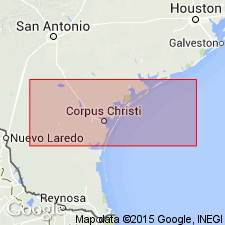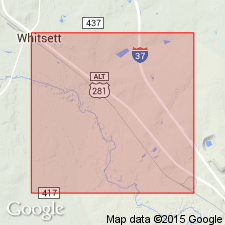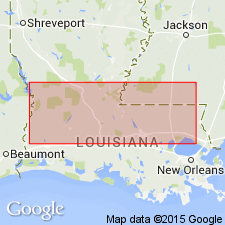
- Usage in publication:
-
- Frio formation [outcrop]
- "Frio" [subsurface]†
- Modifications:
-
- Areal extent
- AAPG geologic province:
-
- Gulf Coast basin
Summary:
Pg. 1616-1620, 1634. Inaccurate correlation of so-called subsurface Frio with surface Frio formation noted. Name Van Vleck sands suggest to replace "Frio" in subsurface.
Source: US geologic names lexicon (USGS Bull. 1200, p. 1433-1434).

- Usage in publication:
-
- Frio [subsurface]
- Modifications:
-
- Overview
- AAPG geologic province:
-
- Gulf Coast basin
Summary:
Annotated bibliography of pertinent papers dealing with term Frio; also shows various uses of term as interpreted by the reviewer.
Source: US geologic names lexicon (USGS Bull. 1200, p. 1433-1434).

- Usage in publication:
-
- Frio Stage [subsurface]
- Frio Formation [subsurface]
- Modifications:
-
- Principal reference
- AAPG geologic province:
-
- Gulf Coast basin
Summary:
Pg. 221-227. History of usage of term Frio in subsurface and proposal of formal type section for Frio Formation and Stage. Plummer [1933] and Ellisor (1933) used Frio as term for subsurface strata thought to be equivalent to surface beds of same name as restricted and defined by Plummer. It has been determined, however, that surface Frio of Texas is outcrop equivalent of subsurface Vicksburg. Between 1933 and 1940, workers, unaware of equivalency of subsurface Vicksburg to surface Frio, adopted term Frio for subsurface strata between middle Oligocene (Anahuac) and Vicksburg. This usage is firmly entrenched in the literature. Suggested that term Frio could be suppressed in case of the surface Vicksburgian equivalent in Texas and another name applied to that unit. Frio Stage is that part of subsurface stratigraphic section between base of Anahuac sediments and top of Vicksburg Stage. In type well, Frio Formation is present from 7,663 to 9,725 feet, whereas the stage continues down to 9,961 feet. Formation consists of dark to very dark, varicolored shales and silty shales and massive to thin-bedded strata of sand and silty sand. Top of formation is top of first sand below MARGINULINA zone of the Anahuacian, and base of lowest sand above Vicksburg Stage is considered base of Frio Formation. Stage in subsurface of Louisiana extends across southern half of State from Sabine River to Pearl River and is situated between base of Anahuacian MARGINULINA zone and top of Vicksburgian. Threefold division of Frio into upper, middle, and lower units is facilitated on basis of lithology and paleontology.
Type locality and well (formation and stage): China gas-distillate field in northeast Jefferson Davis Parish, LA; field is 6 mi southwest of Elton, LA.
Type well: Continental Oil-Union Sulphur, H.J. Shoesmith No. 1 well located 330 ft south and 330 ft east of northwest corner sec. 1, T. 8 S., R. 4 W.
Source: US geologic names lexicon (USGS Bull. 1200, p. 1433-1434).
For more information, please contact Nancy Stamm, Geologic Names Committee Secretary.
Asterisk (*) indicates published by U.S. Geological Survey authors.
"No current usage" (†) implies that a name has been abandoned or has fallen into disuse. Former usage and, if known, replacement name given in parentheses ( ).
Slash (/) indicates name conflicts with nomenclatural guidelines (CSN, 1933; ACSN, 1961, 1970; NACSN, 1983, 2005, 2021). May be explained within brackets ([ ]).

